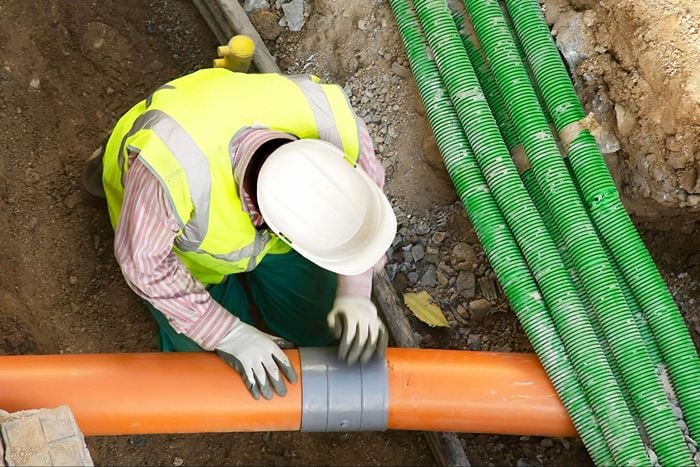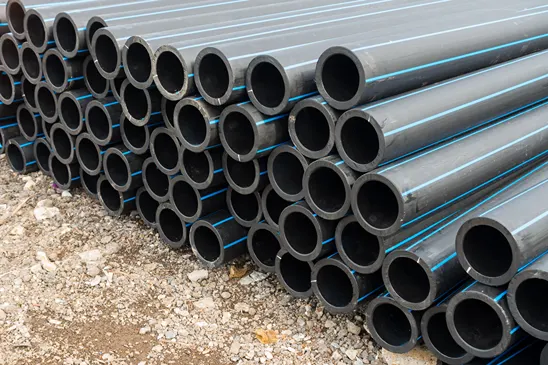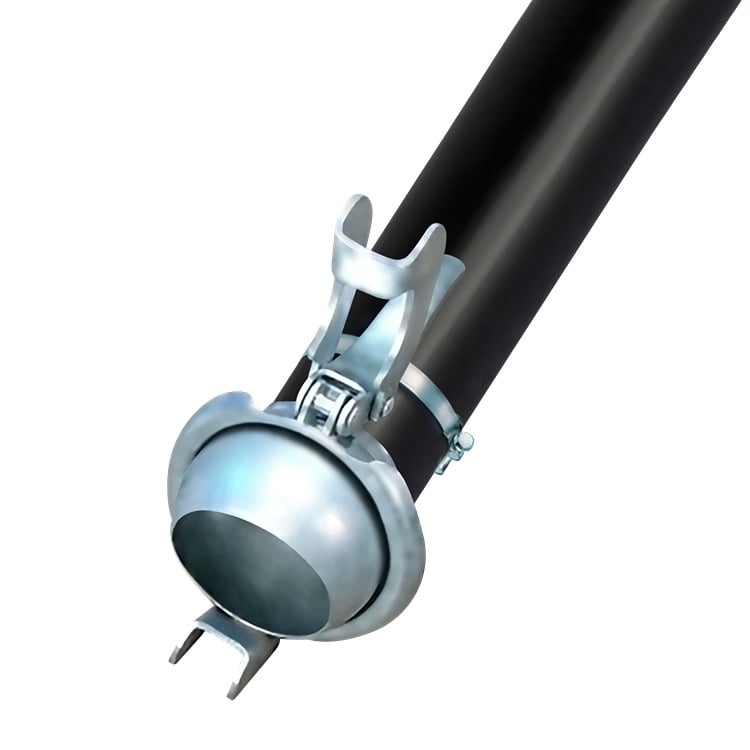At EDDY Pump Corporation, we specialize in providing all-size high-quality HDPE Pipes with Bauer Fittings. These offer quick installation, greater flexibility, cost-efficiency, and durability. Our team also possesses the expertise to help you select the correct pipe size for your specific dredging needs. Trust us for seamless and efficient dredging solutions, unmatched customer support, and for international shipping. Here is a complete guide on how EDDY Pump’s fused HDPE dredge pipe with butt fusion helps you save time, cost, and workforce. Check out our other products!
Why HDPE Dredge Pipes? | The Main Purpose of HDPE Pipes
The primary purpose of these pipes is to transport dredged material, such as sand, gravel, or slurry, from the dredging site to the designated location, such as a disposal area or a reclamation site. These pipes are typically large in diameter to accommodate the high volume of transported material. The smooth interior of these pipes allows for efficient flow and reduces frictional losses during transportation.
These pipes are known for their lightweight construction, making them easier to handle and install than traditional materials like steel. They are also resistant to biological growth and have a long service life, reducing the need for frequent maintenance or replacement.


HDPE Pipe: Construction, Installation Methods | Advantages of HDPE Pipes
Here is some information on these pipes, including installation and advantages over other types of lines for pumping and dredging:
HDPE Pipe Construction:
Manufacturers produce these pipes through extrusion, wherein molten HDPE material is forced through a die, shaping it into the desired pipe form.Depending on the application requirements, they are available in various sizes and dimensions.
Installation Methods:
Depending on the project and environmental conditions, these can be installed using different methods. Some standard installation techniques include:
- Butt Fusion: This method involves heating the ends of the pipes and then joining them under pressure, creating a seamless and leak-free connection.
- Electrofusion: Special fittings with built-in heating elements connect the pipes in this method. When an electric current is applied, the fittings melt the HDPE material and create a strong joint.
- Mechanical Connections: Mechanical connections, such as flanges, compression fittings, or transition fittings, can be utilized to join these pipes. These connections do not necessitate heat or electricity for installation.
EDDY Pump’s Benefits of HDPE Pipes over Other Types of Pipes:
These pipes offer several advantages in dredging applications. Here are some of the critical benefits of using these pipes in dredging:
Abrasion Resistance:
Dredging involves the movement of abrasive materials such as sand, gravel, and sediment. HDPE pipes are highly resistant to abrasion, ensuring they can withstand the harsh conditions of dredging operations without significant wear or damage. This qulaity increases durability and reduces the need for frequent pipe replacement or repair.
Corrosion Resistance:
These pipes are highly resistant to corrosion, even in environments with high levels of saltwater or chemical exposure. This feature makes them ideal for dredging applications where pipes are in contact with corrosive substances. The corrosion-resistant nature of these pipes helps maintain their structural integrity and prolong their lifespan.
Flexibility:
The pipes are flexible, allowing them to accommodate ground movement, waves, and other dynamic forces during dredging activities. Their flexibility reduces the risk of pipe damage and failure caused by external stresses and actions. This flexibility is particularly advantageous in marine and coastal dredging projects.
Floatability:
HDPE pipes have inherent buoyancy due to their low specific gravity. This property makes them naturally buoyant and enables them to float on water, reducing the need for additional flotation devices or supports. The floatability of these pipes simplifies the installation process and provides cost savings for equipment and labor.
Light Weight:
These pipes are lightweight compared to other types used in dredging, such as steel pipes. This characteristic makes it easier to handle, transport, and install. The reduced weight simplifies logistics, minimizes installation costs, and facilitates quicker deployment of dredging operations.
Long Lengths:
Long lengths of these pipes, often up to 50 meters or more, can be manufactured, depending on the diameter requirements. Longer pipe lengths minimize the joints required in the dredging pipeline system. Fewer joints reduce the risk of leaks, enhance structural integrity, and improve overall operational efficiency.
Cost-Effectiveness:
HDPE pipes’ durability, longevity, and low maintenance requirements contribute to their cost-effectiveness in dredging projects. They offer reduced lifecycle costs compared to other pipe materials due to their resistance to abrasion, corrosion and the need for fewer repairs and replacements over time.
Overall, using HDPE pipes in dredging applications provides significant durability, flexibility, corrosion resistance, buoyancy, and cost-effectiveness advantages. These benefits make HDPE pipes preferred for various dredging operations, including harbor maintenance, channel dredging, land reclamation, and beach nourishment projects.
EDDY Pump also offers these HDPE Dredge Pipes already fused with Bauer Fittings. This feature significantly reduces the installation time by not needing to weld and cut the dredge pipe onsite.
Advantages of Installing HDPE Pipes with Fittings over Fusing Onsite
When installing HDPE dredge pipes, there are two main methods: using pre-fabricated fittings or fusing the lines onsite. There are huge advantages of installing HDPE dredge pipes with fittings compared to combining onsite:
Flexibility in Installation:
Pre-fabricated fittings provide added flexibility in the installation process. Fittings allow for more accessible modifications or changes in the pipeline layout during installation or future system expansions. This flexibility is beneficial when dealing with complex or changing project requirements.
Time and Labor Efficiency:
Installing dredge pipes with fittings can save time and labor compared to onsite fusion. Pre-fabricated fittings enable convenient connection of the pipes through mechanical means, such as flanges or compression fittings. This can lead to faster installation and reduced labor costs.
Compatibility with Existing Systems:
Using pre-fabricated fittings can be advantageous when working on retrofit or repair projects. It allows for easier integration with existing piping systems or connections to different materials, such as transitioning from HDPE to other pipe materials or joining pipes of different sizes or types.
Reduced Equipment Requirements:
Onsite fusion requires specialized fusion machines and accessories, which can be costly to purchase or rent. Using pre-fabricated fittings eliminates the need for fusion equipment, reducing equipment costs and the complexity associated with fusion operations.
Mitigating Environmental Factors:
Onsite fusion requires favorable weather conditions, as extreme temperatures, high humidity, or adverse weather can affect the fusion process. With pre-fabricated fittings, the installation is not as dependent on weather conditions, ensuring more consistent and reliable installation regardless of environmental factors.
Quality Control:
Pre-fabricated fittings are manufactured under controlled conditions, ensuring consistent quality and performance. Each fitting undergoes rigorous testing and quality control processes, assuring their integrity and reliability. Onsite fusion, while effective when done correctly, may be subject to human error or inconsistencies if not performed by trained professionals.
For non-permanent dredging projects involving 100,000 cubic yards or less of material, a fused dredge pipe is an ideal choice due to its cost-saving benefits during installation and demobilization and its more straightforward installation process.
Conclusion
Overall, HDPE dredge pipes offer several advantages for dredging operations, including high durability, chemical resistance, lightweight design, and low maintenance requirements. These features contribute to the efficiency and cost-effectiveness of dredging projects.

Frequently Asked Questions about HDPE Pipes/ HDPE Dredge Pipes
1: What is HDPE, and What is HDPE Pipe?
HDPE stands for High-Density Polyethylene, a type of plastic commonly used for pipes and fittings in various applications, with dredging and pumping slurry being one of the most common and best. HDPE pipes are known for their durability, strength, and versatility.
2: What is HDPE Dredge Pipe?
HDPE (High-Density Polyethylene) Dredge Pipe is designed explicitly for dredging operations. Dredging removes sediment, debris, or other materials from bodies of water, such as rivers, lakes, or harbors, to create or maintain navigation channels, waterways, or ports.
3: What are dredge pipes made from?
HDPE Dredge Pipes are made from high-density polyethylene, a durable and flexible thermoplastic material. HDPE has excellent resistance to abrasion, corrosion, and chemical reactions, making it well-suited for use in harsh environments, including marine applications.

Frequently Asked Questions about HDPE Pipes/ HDPE Dredge Pipes
1: What is HDPE, and What is HDPE Pipe?
HDPE stands for High-Density Polyethylene, a type of plastic commonly used for pipes and fittings in various applications, with dredging and pumping slurry being one of the most common and best. HDPE pipes are known for their durability, strength, and versatility.
2: What is HDPE Dredge Pipe?
HDPE (High-Density Polyethylene) Dredge Pipe is designed explicitly for dredging operations. Dredging removes sediment, debris, or other materials from bodies of water, such as rivers, lakes, or harbors, to create or maintain navigation channels, waterways, or ports.
3: What are dredge pipes made from?
HDPE Dredge Pipes are made from high-density polyethylene, a durable and flexible thermoplastic material. HDPE has excellent resistance to abrasion, corrosion, and chemical reactions, making it well-suited for use in harsh environments, including marine applications.
Conclusion
Overall, HDPE dredge pipes offer several advantages for dredging operations, including high durability, chemical resistance, lightweight design, and low maintenance requirements. These features contribute to the efficiency and cost-effectiveness of dredging projects.

About EDDY Pump:
EDDY Pump Corporation is a leading pump manufacturer and dredge engineering company. We are dedicated to providing state-of-the-art technology and exceptional service to our clients.
Our patented pump technology outperforms centrifugal, vortex, and positive displacement pumps, particularly in challenging pumping applications with high solids content.
With longer maintenance intervals, our pumps ensure increased output, uptime, and profitability. Discover our product range below to find the perfect fit for your project needs.
Contact us at 619-404-1916 for assistance.
Get Expert Selection Help
Buy HDPE Pipe or HDPE Dedge Pipe with best quality yet great value for money.
Applications Include: Dredging, Construction, Excavation, Oil and Gas, Mining, Sewage Water treatment and more.
